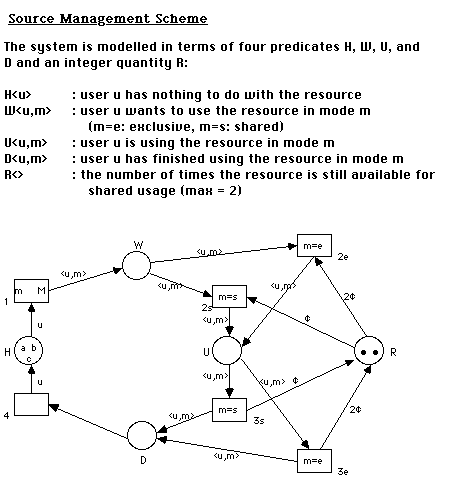PREDICATE TRANSITION NETS
Predicate/Transition (Pr/T) Nets, also called High-Level Petri Nets in general, have been first introduced by H. J. Genrich and K. Lautenbach (in [gl81]) and were the first class of high-level Petri Nets.
Definition
(according to [gl81])
A Pr/T Net consists of the following constituents:
- a directed net (S, T; F) where

- a structure ½ consisting of some sorts of individuals
together with some operations and relations
- a labelling of arcs assigning to all elements of F a formal sum of n-tuples of variables where n is the arity of the predicate connected to the arc
- an inscription on transitions assigning to some elements of T a logical formula built from ½ where variables occurring free in a transition have to occur at an adjacent arc
- a marking M of predicates S with formal sums of n-tuples of individuals (items)
- a function K which assigns to the predicates an upper bound for the number of copies of the same item which it may carry
- the transition rule which expresses the common interpretation of Prt/T nets:
A transition may occur, for an assignment of individuals to the variables which satisfies the formula inscribed to the transition, if all input predicates carry enough copies of proper items and for no output predicate the capacity K is exceded by adding the respective copies of items.
The set of all markings connected to M through such occurrences of transitions is denoted by [M>].
Sample Net
(from [gl81])

Tools
PROD is a reachability analysis tool.
POSES is a simulation and development system, which uses an extended Pr/T Net model.
COMBAG is a tool for the computation of invariants.
INCOME is a set of user-oriented tools for modelling, simulation and implementing business processes.
PSITool is an analysis tool for stochastic high-level Petri Nets.
References
- H. J. Genrich, K. Lautenbach: System Modelling with high-level Petri Nets [gl81]
- H. J. Genrich, K. Lautenbach: S-invariance in Predicate/Transition Nets [gl83]
- W. Reisig: Petri Nets. An introduction [rei85a]
- H. J. Genrich: Predicate/Transition Nets [gen87]
BACK

